44-year-old American Sandra Magnus held in low Earth orbit of 133 days
 Bashny.Net
Bashny.Net
Why Velcro - the main one astronaut, flying water - one of the main dangers that lies in wait for him, and tortilla - the main meal? The explanation can be found in the online diary Sandra Magnus, who she was 4, 5 months working as a flight engineer on the International Space Station.
18 photos via fototelegraf

44-year-old American Sandra Magnus held in low Earth orbit of 133 days - from 14 November 2008 to 28 March 2009. Together with cosmonaut Yuri Lonchakov and astronaut Michael Fincke, she participated in the 18th expedition to the International Space Station. It was not the first flight into space Magnus: In 2002, she participated in the expedition of the space shuttle Atlantis STS-112. However, the ISS for the first time led by Magnus online diary. Permanent internet connection is not the station, so that their records and answers to readers' questions Magnus sent by e-mail - sometimes with considerable delay - on land, in the Science and Technology University of Missouri, where editors put them in your blog spacebook.mst.edu .
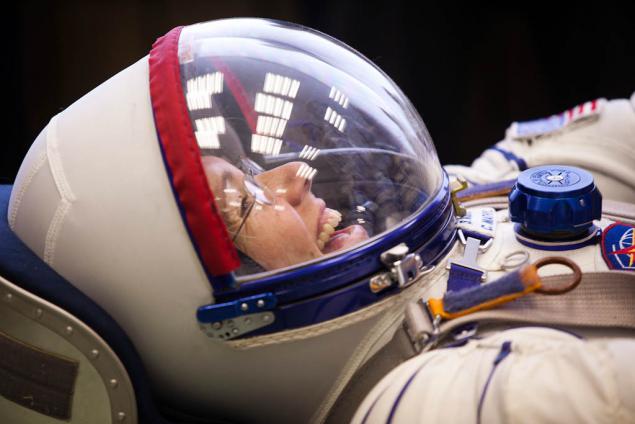
How to fly into space
Well, I'm back in space. First, let's talk about the launch. I was sitting on the middle deck, so that access to the window I did not have. We listened to the countdown, and only when it was announced that before the start of nine minutes left, realized that we go somewhere so fly. We felt like checking gimbal jet engine, and waited for the main start up. Small vibration, our chair was shake and six seconds shook in earnest, and we felt the same "blow to the chair," which tells about all the astronauts. We soared from the launch pad. Once separated the first stage, it was noticeably quieter, softer and stroke. Before separating the main engine we felt that overload reached 3g. It seemed to last forever. It feels as if perched on the chest 100-pound gorilla. But in fact, the main engine had separated almost immediately, and overloading zakonchilas.Kogda reaching orbit, the main thing - at first moving slowly.
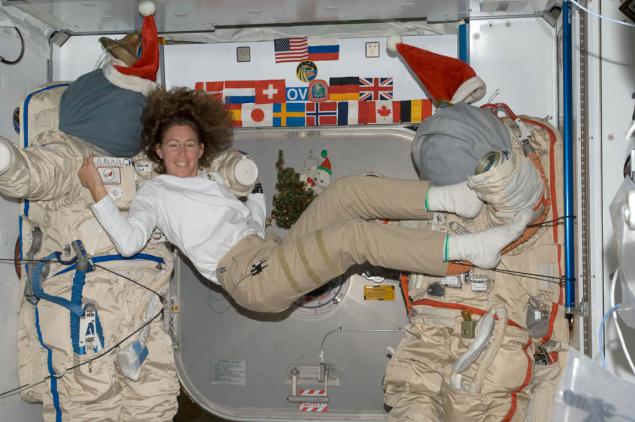
The first strong feeling that I got from the chair otstegnuvshis: floating upwards. It seemed as if I am for something that is not uhvachena, and then fly away to the ceiling. My vestibular system has not yet realized that the force of attraction is no more, and it confuses me with their signals. We have on the middle deck was a lot of cases, so it was impossible to follow the rules by which the first day in orbit need to save space "orientation 1g» (that is, to preserve the so-called vertical orientation with respect to the main elements of the shuttle. - Esquire). I shook from side to side, twist upside down and back, up and down. It was very difficult to control the body had to move very slowly, but the legs and other limbs dangling as they please. I experienced great relief when I finally managed to escape from the hot and stuffy suit. By the end of the day I have remembered how to move in zero gravity, and, as usual, he was attached to the ceiling.

As in space to go online and watch TV
We do not have TV, but from the center of the flight control, we sometimes send files from TV shows and movies. But our expedition conducting an experiment with the Internet. There is only e-mail and IP-telephony, where there is satellite communications with Earth. The experiment involved only one computer, which is not connected to any of our systems and receives the internet signal from the MCC via satellite. It is important that the computer has been fully isolated, that we may not have picked up any of terrestrial viruses.
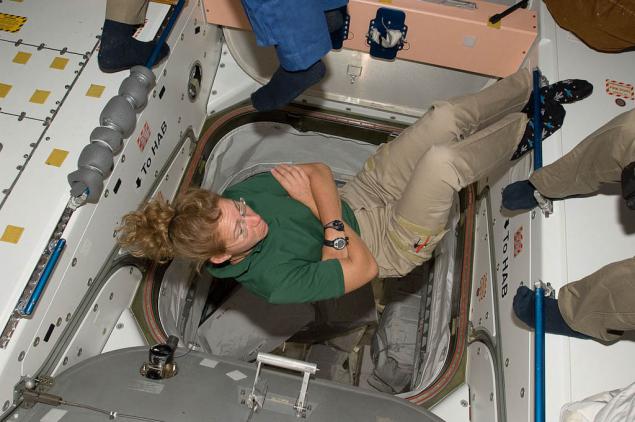
How to sleep in space
The task is not simple, quite frankly. You probably do not realize it, but we are all accustomed to the fact that when we fall asleep, we have on the force of gravity. Through this power, we can lie down on the bed, and our heads are on the pillow. The first time I went to sleep in zero gravity, I have always had the feeling that I'm falling and I waited, and when I hit the floor. After some time, I learned how to wear a seat in his sleeping bag and got used to the fact that was floating in the air during sleep (and do not feel at a hard surface such as a bed).
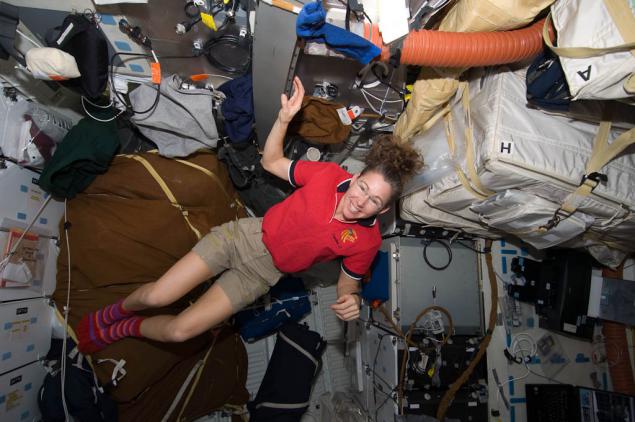
How to dress in space
Imagine that you live in a place where nothing can be put or put. If you do something somewhere put or place, it immediately fly away and disappear. No stability. Now think how often during the day you have something somewhere to put, or put ... Here you woke up and got out of bed. Your bed is on the floor, where it holds the force of gravity. You go to the closet to get clothes. Clothes hanging in the closet, because it holds the power of attraction. You shoot pajamas and throw it on the floor or in a laundry basket. There she is, because it holds the power of attraction. In general, you will probably understand and can continue on their own thought experiment. The problem is that we're at the top, a luxury denied the force of attraction.
In the morning I wake up and get out of the sleeping bag, which is attached to the wall. When I open the container to get her clothes, she and strives to scatter around the bay, and all at once. When I take off my pajamas, she, too, flies somewhere, has to chase her to stick to the wall with Velcro. Of course, the more difficult the task, the stronger the need to think twice before for her to undertake. And so in all. If you for some reason need tools, they need to not only find, but put in a container from which they can not fly away (trust me, you'll have a hard time if the space you have lost some small tool!). Frankly, there is nothing easier than to lose something on the ISS! That is why the Velcro - the main one astronaut.
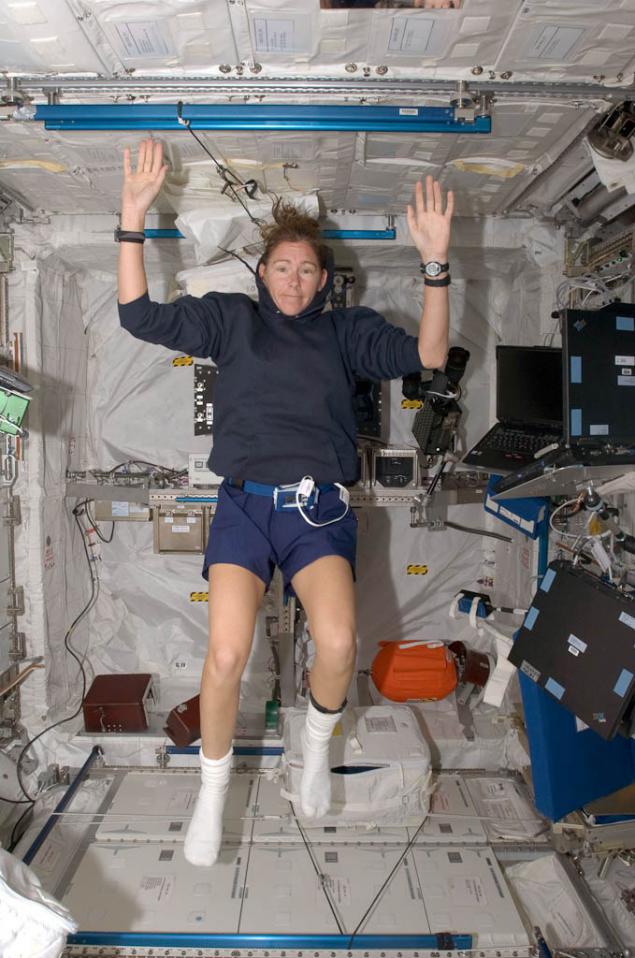
...

How to go to the bathroom in space
Okay. You have long been waiting for - get. Actually, on second thought, it's an interesting engineering problem. What's going on in the world, when you go to the toilet? On Earth, gravity works, thanks to which it all falls down the toilet. Now imagine what happens if there is no gravity. The designers for a long time struggled with the cosmic sort, because they had to come up with a way to isolate the urine and faeces and put them in a special tank. It was found that the air flow can be the handle, with the result that the toilet operates on the principle of a vacuum cleaner. When you go to the bathroom in space - no matter on the shuttle or the ISS - the first thing to do - turn on the fan, pump air into a special hose, in which you will be doing all his work. Air streams carry urine, and it is transported through a hose into the tank. With the stool - the same thing. Turn on the fan, tight ass close the outlet of the hose, and the air blows everything away. It works just fine!
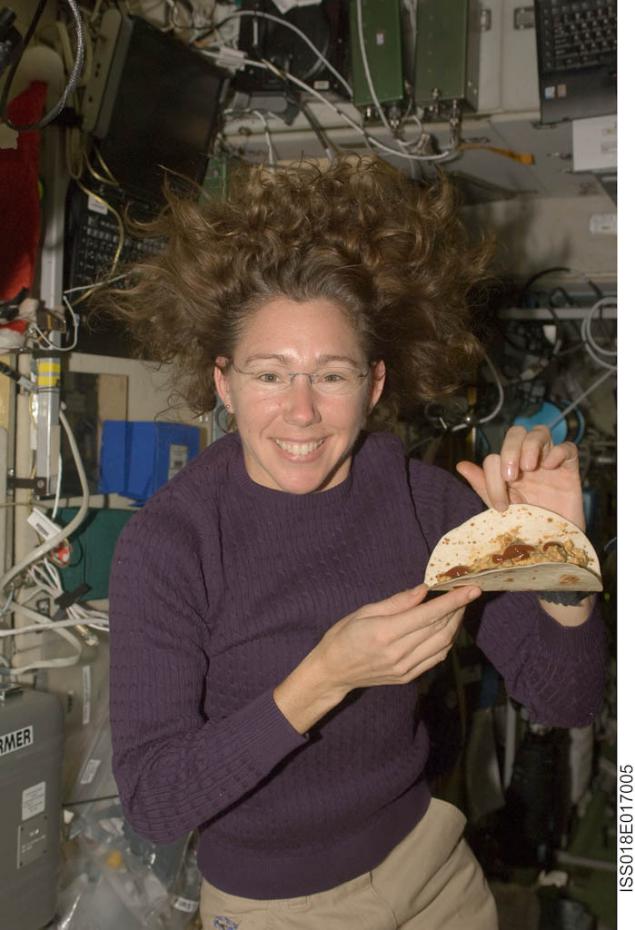
Why space needed tortilla
Tortilla in space - is the cornerstone of the first case. We eat tortillas instead of bread, because they do not crumble. Just imagine what would have happened if we had been in orbit bread, constantly falling apart into small pieces and crumbs! They would not fall on the floor, not - they'd rather be flying all over the station and could even get into your eyes, which is extremely unpleasant. A tortilla become a such a versatile vehicle for any meal. I can not think of anything that can not be wrapped in a tortilla and spread it, and why would we not put or smeared. Accordingly, the main goal of any crew - to ensure the necessary supply of this product on board to everything literally floated in tortilla (on demand unless they are inferior to caffeine).
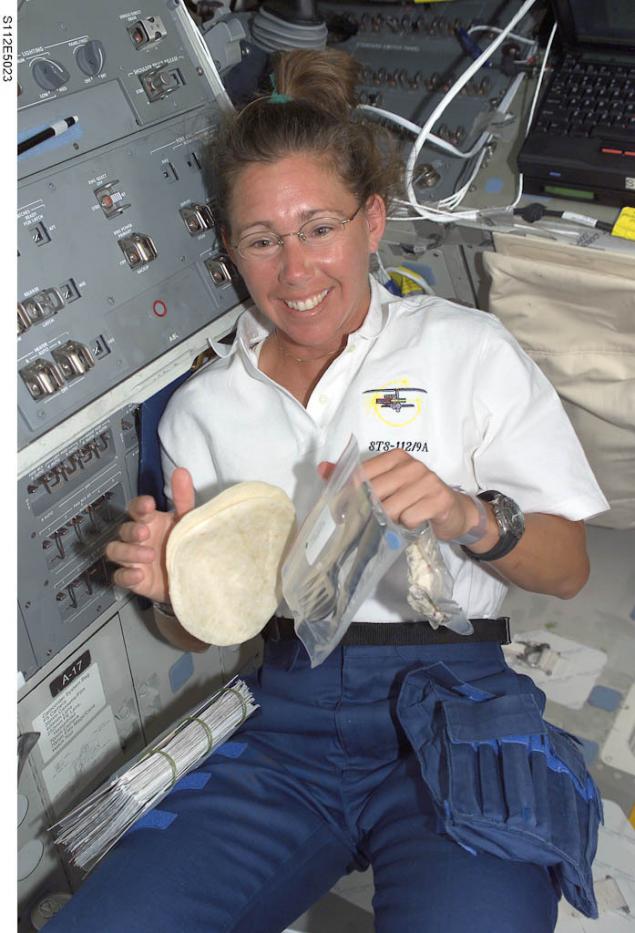
The fact that even a 16-day cycle power created in accordance with our preferences in some point boring. And with all the tortilla becomes much more fun: you can, for example, spread her black beans, add some melted cheddar cheese, hot sauce, and - voila, a whole new taste! Why have not I smeared on a tortilla: applesauce and peanut butter, ground beef, tomatoes, artichokes (dehydrated) and salsa, tuna with mayonnaise and mustard, vanilla pudding with strawberries ... However, my favorite dish is warmed melted cheddar, tortilla and a little salsa - it turns the space cheese quesadilla. This recipe taught me Peggy Whitson (American biochemist, an astronaut, a participant of the 5th expedition to the ISS in 2002 and the commander of the 16th expedition in 2007. - Esquire), when I was in space for the first time.
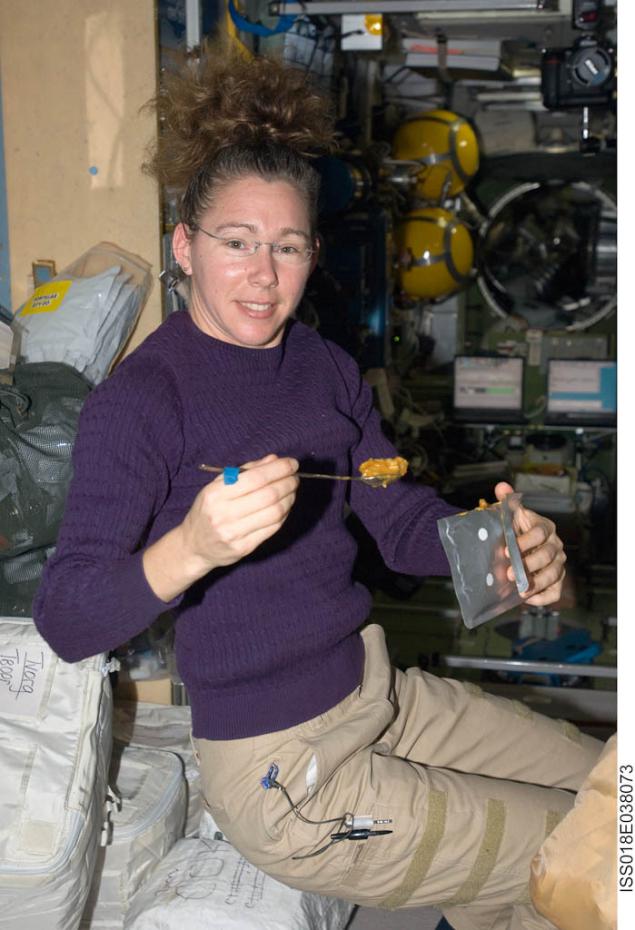
12
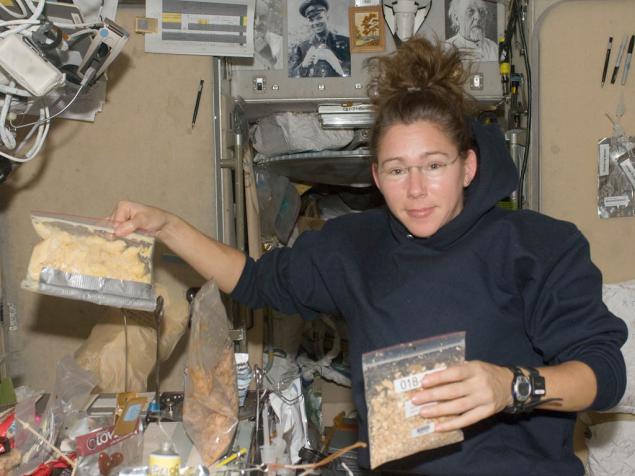
What to do in space with onion and garlic
And here's another little trick that I learned from Peggy Whitson: how to cook fried (baked? Braised?) Russian garlic in food warmers (it is usually warm up canned food and all sorts of banks). Fruits, onions and garlic we brought Russian "Progress" and our shuttles. To prepare the garlic (and I add to it yet, and onions), take a packet of foil - from those in which the Russian store their dehydrated food - put in a garlic and coarsely shredded onion, add a little olive oil, are folded foil to bag It fits in the heater, and turn it on. The device works only 30 minutes, so you need to swim every half hour and turn it on again. When you repeat the process 4-5 times, you'll have a baked garlic and onions.
Using these ingredients and some spices, for example, I have prepared two kinds of tuna, one with baked onions and sweet mustard, the other - with onion, garlic, ginger paste and mayonnaise. And at Christmas I made from white tuna steaks, fried in Texas with lemon and garlic sauce. I even prepared Russian salad of crab sticks, corn and eggs (egg powder had to be used, from which we make omelets, but in a good routine needs boiled eggs). Just for fun, I added a little bit to get the fuck ... By the way, egg powder and corn - a nightmare of space cooks, because they have almost no moisture. Corn loves to stick to everything around, including the spoon and egg powder - an ardent supporter of the entropy (scatter in all imaginable directions!). I have some plans for the New Year and Russian Christmas, but they are quite vague.

How to take a shower in space
In fact, we do not take a shower - we wipe with a damp sponge. Gravity is very helpful if you need to take a shower. Just climb into the bath, turn on the water and it flows to you from top to bottom, and then goes into the sewer. But if there is no force that pulls water down this orderly system it does not really work. If you turn on the shower in space, water will flow from it, and so it will remain, gathering in one big drop. If you can separate the drop from the shower and it also will float your way, you have to be very careful and make sure that water does not hit you in the nose and mouth (otherwise not be able to breathe). And even if all goes well, then you have to get rid of all the water - to the last drop, or by using a special towel, or by air currents, which sleeves it in a safe place.
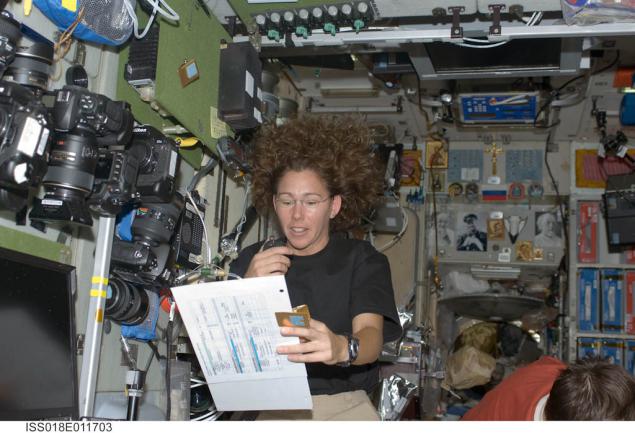
How to read the books in the space
Great question! In fact, the page is constantly wrapped up, and it's terribly annoying. Therefore, we use special clothespins.

16
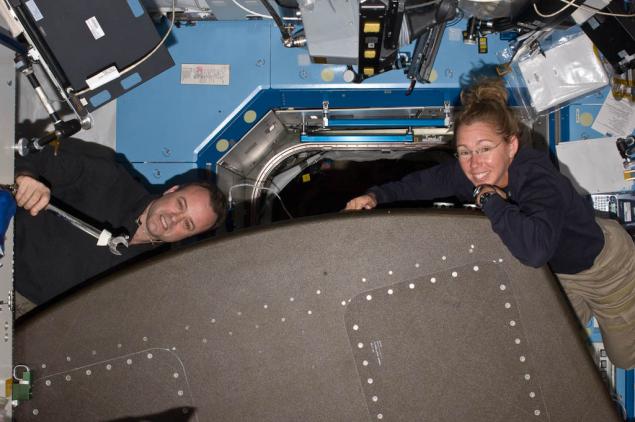
17
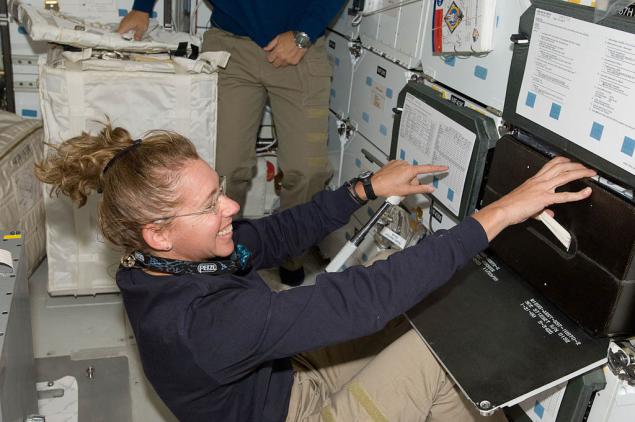
18
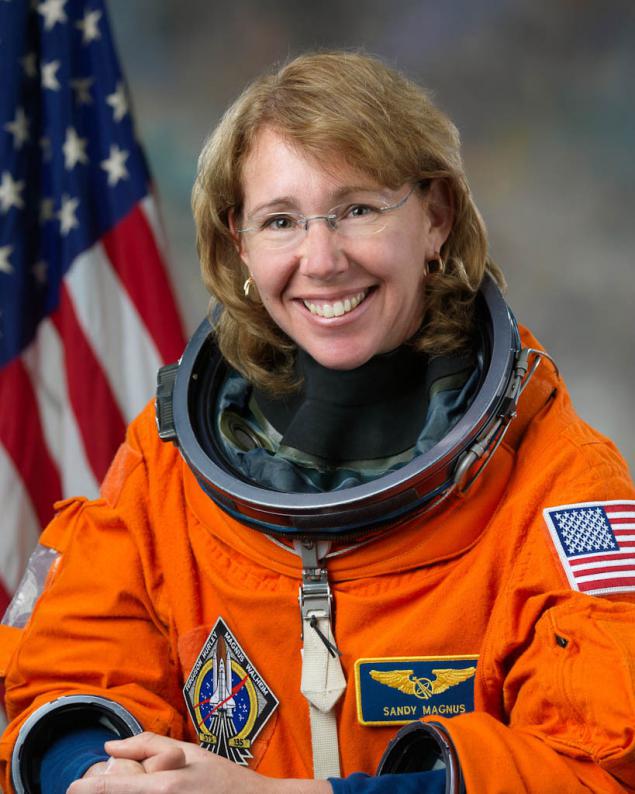
Source:
18 photos via fototelegraf

44-year-old American Sandra Magnus held in low Earth orbit of 133 days - from 14 November 2008 to 28 March 2009. Together with cosmonaut Yuri Lonchakov and astronaut Michael Fincke, she participated in the 18th expedition to the International Space Station. It was not the first flight into space Magnus: In 2002, she participated in the expedition of the space shuttle Atlantis STS-112. However, the ISS for the first time led by Magnus online diary. Permanent internet connection is not the station, so that their records and answers to readers' questions Magnus sent by e-mail - sometimes with considerable delay - on land, in the Science and Technology University of Missouri, where editors put them in your blog spacebook.mst.edu .

How to fly into space
Well, I'm back in space. First, let's talk about the launch. I was sitting on the middle deck, so that access to the window I did not have. We listened to the countdown, and only when it was announced that before the start of nine minutes left, realized that we go somewhere so fly. We felt like checking gimbal jet engine, and waited for the main start up. Small vibration, our chair was shake and six seconds shook in earnest, and we felt the same "blow to the chair," which tells about all the astronauts. We soared from the launch pad. Once separated the first stage, it was noticeably quieter, softer and stroke. Before separating the main engine we felt that overload reached 3g. It seemed to last forever. It feels as if perched on the chest 100-pound gorilla. But in fact, the main engine had separated almost immediately, and overloading zakonchilas.Kogda reaching orbit, the main thing - at first moving slowly.

The first strong feeling that I got from the chair otstegnuvshis: floating upwards. It seemed as if I am for something that is not uhvachena, and then fly away to the ceiling. My vestibular system has not yet realized that the force of attraction is no more, and it confuses me with their signals. We have on the middle deck was a lot of cases, so it was impossible to follow the rules by which the first day in orbit need to save space "orientation 1g» (that is, to preserve the so-called vertical orientation with respect to the main elements of the shuttle. - Esquire). I shook from side to side, twist upside down and back, up and down. It was very difficult to control the body had to move very slowly, but the legs and other limbs dangling as they please. I experienced great relief when I finally managed to escape from the hot and stuffy suit. By the end of the day I have remembered how to move in zero gravity, and, as usual, he was attached to the ceiling.

As in space to go online and watch TV
We do not have TV, but from the center of the flight control, we sometimes send files from TV shows and movies. But our expedition conducting an experiment with the Internet. There is only e-mail and IP-telephony, where there is satellite communications with Earth. The experiment involved only one computer, which is not connected to any of our systems and receives the internet signal from the MCC via satellite. It is important that the computer has been fully isolated, that we may not have picked up any of terrestrial viruses.

How to sleep in space
The task is not simple, quite frankly. You probably do not realize it, but we are all accustomed to the fact that when we fall asleep, we have on the force of gravity. Through this power, we can lie down on the bed, and our heads are on the pillow. The first time I went to sleep in zero gravity, I have always had the feeling that I'm falling and I waited, and when I hit the floor. After some time, I learned how to wear a seat in his sleeping bag and got used to the fact that was floating in the air during sleep (and do not feel at a hard surface such as a bed).

How to dress in space
Imagine that you live in a place where nothing can be put or put. If you do something somewhere put or place, it immediately fly away and disappear. No stability. Now think how often during the day you have something somewhere to put, or put ... Here you woke up and got out of bed. Your bed is on the floor, where it holds the force of gravity. You go to the closet to get clothes. Clothes hanging in the closet, because it holds the power of attraction. You shoot pajamas and throw it on the floor or in a laundry basket. There she is, because it holds the power of attraction. In general, you will probably understand and can continue on their own thought experiment. The problem is that we're at the top, a luxury denied the force of attraction.
In the morning I wake up and get out of the sleeping bag, which is attached to the wall. When I open the container to get her clothes, she and strives to scatter around the bay, and all at once. When I take off my pajamas, she, too, flies somewhere, has to chase her to stick to the wall with Velcro. Of course, the more difficult the task, the stronger the need to think twice before for her to undertake. And so in all. If you for some reason need tools, they need to not only find, but put in a container from which they can not fly away (trust me, you'll have a hard time if the space you have lost some small tool!). Frankly, there is nothing easier than to lose something on the ISS! That is why the Velcro - the main one astronaut.

...

How to go to the bathroom in space
Okay. You have long been waiting for - get. Actually, on second thought, it's an interesting engineering problem. What's going on in the world, when you go to the toilet? On Earth, gravity works, thanks to which it all falls down the toilet. Now imagine what happens if there is no gravity. The designers for a long time struggled with the cosmic sort, because they had to come up with a way to isolate the urine and faeces and put them in a special tank. It was found that the air flow can be the handle, with the result that the toilet operates on the principle of a vacuum cleaner. When you go to the bathroom in space - no matter on the shuttle or the ISS - the first thing to do - turn on the fan, pump air into a special hose, in which you will be doing all his work. Air streams carry urine, and it is transported through a hose into the tank. With the stool - the same thing. Turn on the fan, tight ass close the outlet of the hose, and the air blows everything away. It works just fine!

Why space needed tortilla
Tortilla in space - is the cornerstone of the first case. We eat tortillas instead of bread, because they do not crumble. Just imagine what would have happened if we had been in orbit bread, constantly falling apart into small pieces and crumbs! They would not fall on the floor, not - they'd rather be flying all over the station and could even get into your eyes, which is extremely unpleasant. A tortilla become a such a versatile vehicle for any meal. I can not think of anything that can not be wrapped in a tortilla and spread it, and why would we not put or smeared. Accordingly, the main goal of any crew - to ensure the necessary supply of this product on board to everything literally floated in tortilla (on demand unless they are inferior to caffeine).

The fact that even a 16-day cycle power created in accordance with our preferences in some point boring. And with all the tortilla becomes much more fun: you can, for example, spread her black beans, add some melted cheddar cheese, hot sauce, and - voila, a whole new taste! Why have not I smeared on a tortilla: applesauce and peanut butter, ground beef, tomatoes, artichokes (dehydrated) and salsa, tuna with mayonnaise and mustard, vanilla pudding with strawberries ... However, my favorite dish is warmed melted cheddar, tortilla and a little salsa - it turns the space cheese quesadilla. This recipe taught me Peggy Whitson (American biochemist, an astronaut, a participant of the 5th expedition to the ISS in 2002 and the commander of the 16th expedition in 2007. - Esquire), when I was in space for the first time.

12

What to do in space with onion and garlic
And here's another little trick that I learned from Peggy Whitson: how to cook fried (baked? Braised?) Russian garlic in food warmers (it is usually warm up canned food and all sorts of banks). Fruits, onions and garlic we brought Russian "Progress" and our shuttles. To prepare the garlic (and I add to it yet, and onions), take a packet of foil - from those in which the Russian store their dehydrated food - put in a garlic and coarsely shredded onion, add a little olive oil, are folded foil to bag It fits in the heater, and turn it on. The device works only 30 minutes, so you need to swim every half hour and turn it on again. When you repeat the process 4-5 times, you'll have a baked garlic and onions.
Using these ingredients and some spices, for example, I have prepared two kinds of tuna, one with baked onions and sweet mustard, the other - with onion, garlic, ginger paste and mayonnaise. And at Christmas I made from white tuna steaks, fried in Texas with lemon and garlic sauce. I even prepared Russian salad of crab sticks, corn and eggs (egg powder had to be used, from which we make omelets, but in a good routine needs boiled eggs). Just for fun, I added a little bit to get the fuck ... By the way, egg powder and corn - a nightmare of space cooks, because they have almost no moisture. Corn loves to stick to everything around, including the spoon and egg powder - an ardent supporter of the entropy (scatter in all imaginable directions!). I have some plans for the New Year and Russian Christmas, but they are quite vague.

How to take a shower in space
In fact, we do not take a shower - we wipe with a damp sponge. Gravity is very helpful if you need to take a shower. Just climb into the bath, turn on the water and it flows to you from top to bottom, and then goes into the sewer. But if there is no force that pulls water down this orderly system it does not really work. If you turn on the shower in space, water will flow from it, and so it will remain, gathering in one big drop. If you can separate the drop from the shower and it also will float your way, you have to be very careful and make sure that water does not hit you in the nose and mouth (otherwise not be able to breathe). And even if all goes well, then you have to get rid of all the water - to the last drop, or by using a special towel, or by air currents, which sleeves it in a safe place.

How to read the books in the space
Great question! In fact, the page is constantly wrapped up, and it's terribly annoying. Therefore, we use special clothespins.

16

17

18

Source:
Tags
See also
A trip to England
12 ways to upgrade the children's wardrobe
Unpredictable Sandra
Web diary from space
The ear on his arm
Sunny days in the middle of winter
Events in 2013
"It's just not my face, but I'm grateful for it," says American
18-year-old girl fell into a coma after surgery
















